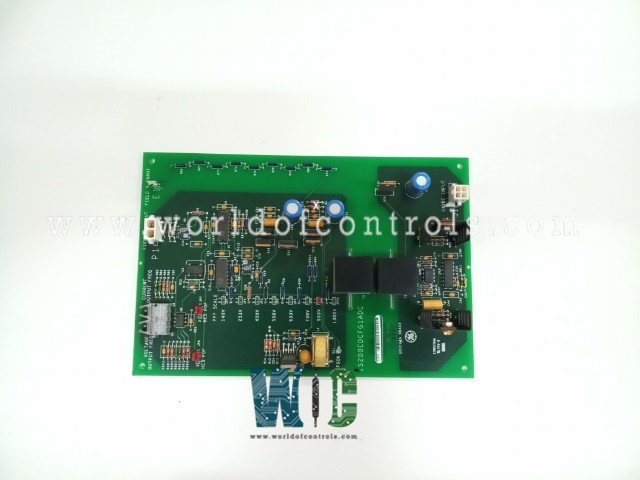SPECIFICATIONS
Part No.: IS200EDCFG1ACB
Manufacturer: General Electric
Country of Manufacture: United States of America (USA)
Technology: Surface-mount
Operating temperature: -30 to 65oC
Product Type: Exciter DC Feedback Board
Availability: In Stock
Series: EX2100
Functional Description
IS200EDCFG1ACB is an Exciter DC Feedback Board developed by GE. It is a part of EX2100 excitation system. The board is a specialized component designed to measure both field current and field voltage at the Silicon Controlled Rectifier (SCR) bridge. These measurements are required for monitoring and controlling the performance of the SCR bridge, which is a key element in power electronics and motor control applications.
Features
- Measurement Capabilities: The primary function of the board is to accurately measure the field current and field voltage. The field current is the current supplied to the field winding of a machine, such as a generator or motor, and is essential for creating the magnetic field necessary for its operation. The field voltage, on the other hand, is the voltage across the field winding. By monitoring these parameters, the board ensures that the SCR bridge operates within its specified limits, maintaining optimal performance and preventing damage due to overcurrent or overvoltage conditions.
- High-Speed Fiber-Optic Link: The board interfaces with the EISB board located in the control panel via a high-speed fiber-optic link. This fiber-optic connection serves several important purposes:
- Voltage Isolation: Fiber-optic cables provide inherent voltage isolation between the board and the EISB board. This isolation is crucial for protecting the control system from high-voltage transients and ensuring the safety and integrity of the measurement system.
- High Noise Immunity: Fiber-optic communication is highly immune to electrical noise, which is often present in industrial environments. By using fiber optics, the board can transmit accurate measurements without interference from electromagnetic noise, ensuring reliable data transmission.
- Dedicated Channels: The system uses two separate fibers, one for each signal (field current and field voltage). This dedicated channel approach prevents crosstalk and ensures that each signal is transmitted clearly and accurately to the EISB board.
- Integration and Application: Integration with the EISB board over a fiber-optic link is a well-engineered solution for high-precision measurement and control applications. This setup is particularly beneficial in environments where electrical isolation and noise immunity are critical, such as in power plants and industrial automation systems. The board's ability to accurately measure field current and voltage and transmit this data reliably to the control system helps in maintaining efficient and safe operation of electrical machinery.
Power Supply
- The board receives its power from an external 24 V DC power source, which is then regulated to provide stable voltage levels required for its operation. This power conversion process involves three voltage regulators that transform the ±24 V DC input into +15 V DC, -15 V DC, and +5 V DC outputs. These regulated voltages are crucial for supplying different components on the board with the appropriate operating voltages necessary for their functions.
- +15 V DC Regulation: One of the voltage regulators converts the ±24 V DC input into a regulated +15 V DC output. This voltage level is typically used to power analog circuits, operational amplifiers, and other components that require a positive voltage supply.
- -15 V DC Regulation: Another voltage regulator produces a regulated -15 V DC output from the same 24 V DC input. The -15 V DC voltage is commonly used to power negative rail circuits, such as operational amplifiers and analog signal processing circuits.
- +5 V DC Regulation: A third voltage regulator generates a regulated +5 V DC output. This voltage level is essential for digital circuits, microcontrollers, logic gates, and other digital components that operate at lower voltage levels compared to analog circuits.
Field Current Feedback System
- In the context of the SCR bridge, the field current feedback system plays a critical role in monitoring and controlling the current supplied to the field winding of a machine, such as a generator or motor. This system utilizes precise measurement techniques to ensure the stability and efficiency of the operation.
- Field current is typically measured across a DC shunt located at the SCR bridge. A DC shunt resistor is placed in series with the field winding, creating a small voltage drop proportional to the current passing through it. For instance, a maximum voltage drop of 500 mV corresponds to the highest field current level. This low-level voltage signal, representing the field current, is then fed into a differential amplifier for further processing.
- The differential amplifier amplifies the low-level voltage signal received from the DC shunt. Its primary function is to increase the amplitude of the signal to a level suitable for further processing and control. The output voltage range of the differential amplifier typically spans from -5 V to +5 V. This amplified signal accurately represents variations in the field current, allowing for precise monitoring and adjustment of the SCR bridge's performance.
The WOC team is always available to help you with your EX2100 requirements. For more information, please contact WOC.
Frequently Asked Questions
What is IS200EDCFG1ACB?
It is an Exciter DC Feedback Board developed by GE under the EX2100 series.
Why is measuring field current and voltage important?
Field current and voltage measurements are crucial for monitoring the operational state of the SCR bridge. They help ensure the bridge operates within safe limits, optimizing efficiency and preventing damage from overcurrent or overvoltage conditions.
In what applications is the board typically used?
The board is commonly used in power plants, industrial automation systems, and other environments where precise measurement and control of SCR bridges are essential for reliable operation of electrical machinery.
How does the board contribute to system reliability?
By accurately measuring and monitoring field current and voltage, and transmitting this data over a secure fiber-optic link, it enhances system reliability. It ensures that critical parameters are continuously monitored, reducing the risk of equipment failure and optimizing uptime.
